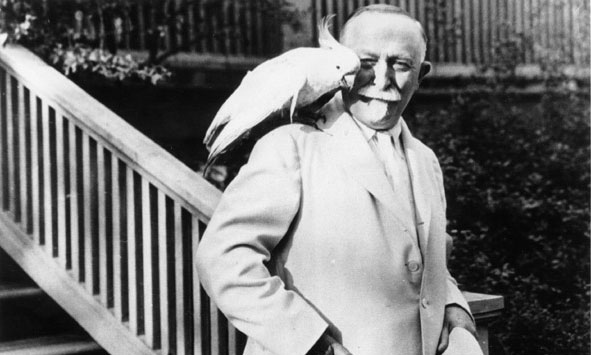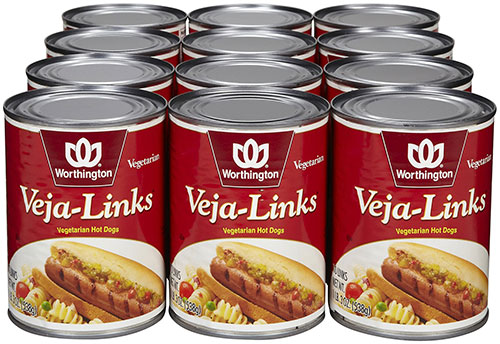How The Fake Sausage Is Made
Veggie burgers and similar products are downright common these days, but it took a long time for meat analogues to earn respect at the table.
$553M
The size of the meat alternatives market in 2012, an 8 percent increase from 2010, according to Mintel research. In recent years, fake meat options have increased significantly, with firms such as Hampton Creek Farms, Gardein, and Beyond Meat giving the space a little Silicon Valley swag.
Five early examples of restaurants embracing vegetarianism
- In 1895, the Vegetarian Society of New York opened up the one of the first vegetarian restaurants in the city, the branding-free "Vegetarian Restaurant No. 1." On its first night, the restaurant served fruit soup and Graham Bread—the latter being a good fit, due to the fact that Graham crackers were invented as a form of vegetarian food. (It must drive Samuel Graham crazy that they're commonly eaten with marshmallows, which aren't vegetarian.)
- In the early 20th century, entrepreneurs Herman and Sadie Schildkraut had managed to build a chain of 15 different vegetarian restaurants in New York City—more than the number of Panera Bread locations you'll find today. For some reason, however, the Schildkrauts' veggie chains have not proven as culturally relevant as Papaya King or Katz's Deli.
- The Mortimer Pure Food Café in Chicago was one of many vegetarian restaurants to come about with the "pure food" monicker during the first decade of the 20th century—a phrase with special meaning, due to the fact that the law that created the Food and Drug Administration was called the Pure Food and Drug Act of 1906. The restaurant, which served baked beans and asparagus on toast, was damaged in a fire in 1913.
- Early fast-food restauranteur William Childs, a vegetarian himself, came up with the idea to only sell vegetarian options at his chain of restaurants during the 1920s, out of concerns of public health. That plan didn't work out so well for him.
- In London, an all-vegetarian restaurant called Cranks launched in 1961, proving hugely popular with the public at large and being seen as a major influence in the rise of vegetarianism in the country. However, it didn't stick around long enough to see the trend all the way through, mostly closing up shop in 2001 and living on as a line of sandwiches.
"Even the vegetarians are preparing to be bold trenchermen this Thanksgiving, although without the benefit of turkey, stuffed or otherwise."
— A 1941 New York Times article describing the Thanksgiving plans of the Vegetarian Society of New York, which was planning a feast of salsify, a turnip-type root plant that had gained popularity as a meat analogue. Around 150 members of the group got together that year to eat some hearty veggies. (Yes, the NYT is just like your annoying uncle.) A 2007 article in the Jewish magazine The Forward, however, noted that the tradition was not played for laughs as it was by the Times back then, and often played a religious role.

You can thank Seventh-day Adventists for the modern veggie burger
You may have heard that Kellogg's currently makes your Morningstar Farm burgers, but what you may not have known is exactly how far that history goes back.
See, John Harvey Kellogg (above) originally got into the food business to make some vegetarian food options for his local community in the Battle Creek, Michigan area. Kellogg, his family, and many others moved to the city in part to start a local chapter of the Seventh-day Adventist movement.
Kellogg soon started the Battle Creek Sanitarium, which emphasized the value of healthy living, experimented with different kinds of food, and eventually invented the modern form of cereal basically by accident.
In the process, he got into a bitter feud with his more traditional brother—who eventually turned those products into a hugely successful company. But while the older Kellogg was feeling spurned, he found an opportunity to create a company of his own, the Battle Creek Food Company. This company focused almost entirely on fake meats, with perhaps the best known of the time being Protose.
That product—a combination of wheat gluten, peanuts, and soy—was one of the first efforts to create a meat analogue in the modern era. While pure wheat gluten (now known as seitan) and soy bean curd (better known as tofu) have been around generations, Kellogg's effort proved fairly inspirational in the invention of fake meats as we think of them now.

The birth of the veggie dog
See, some fans of Protose in the Seventh-day Adventist stronghold of Worthington, Ohio came up with the idea to make these veggie foods into things that actually sorta resembled the foods that people actually eat. (One of those fans, Dr. George Harding, was actually a relative of former president Warren G. Harding.)
The result of these early efforts led to the creation of Worthington Foods, which released two canned veggie meat products in 1949: Soyloin Steaks and Meatless Wieners. (You can still buy a variation of the latter today.)
After a few decades of Worthington's early work on this front, they ended up selling the company to a firm called Miles Laboratories. That firm launched a sister company which you probably actually recognize: Morningstar Farms, which took the groundwork from Worthington's patents and created a brand that would sell well to the mass market. (It worked.)
Over the years, Worthington changed hands again multiple times—eventually, coming full circle by falling into the hands of the Kellogg company—which last year held onto the Morningstar Farms brand and handed off Worthington and a sister company, Loma Linda Foods, to a natural foods company. Seems about right.
"It's very hard to explain 50 percent of the soy [in a product] being genetically engineered as just a slip up. This seems to be a company that just doesn't care."
— Greenpeace official Charles Margulis, speaking in a 2001 interview to the Los Angeles Times about Kellogg's apparent usage of genetically modified organisms in Morningstar Farms veggie burgers. (The company said it was accidental.) In a great irony considering Kellogg's long history as a company born off the back of the health food movement, the firm has largely been considered a heavy user of GMOs in food—having long faded away from the health food movement. And things appear not to have improved: A 2014 study from Consumer Reports found that two varieties of Morningstar Farms fake meats tested positive for GMOs, along with a variation of Boca Burgers.
If you ever wanted to live like John Harvey Kellogg once did, we're sorry to say that Protose is no longer on the market, having fallen off the shelves around 2000—about the time that Kellogg purchased Worthington. (Considering the quote above, it kind of makes sense.)
But that hasn't stopped some enterprising folks from putting in their own efforts at creating the meat alternative. One person who has gone out of their way to create it say it's tasty, but mushy; another was non-plussed about the result the first time around but loved it after trying again.
If you don't want to go to the trouble of mixing your own soy, peanut butter, and gluten together, there is one other option: Another company that makes fake meat, Cedar Lake, produces a food called Proteinut, which is about as close as you're likely to get without traveling in time to stay at the Battle Creek Sanitarium.
It's hard to get the real deal when you're eating fake meat.
:format(jpeg)/2018/11/wemowmxr1xgbud94pvm8b.gif)
/2018/11/wemowmxr1xgbud94pvm8b.gif)

/uploads/ernie_crop.jpg)